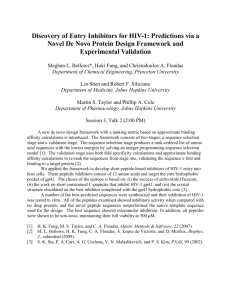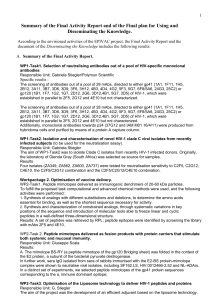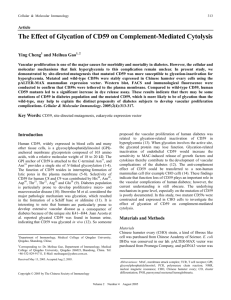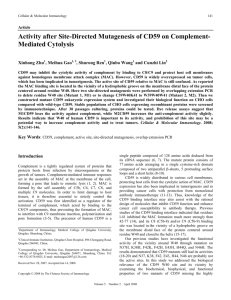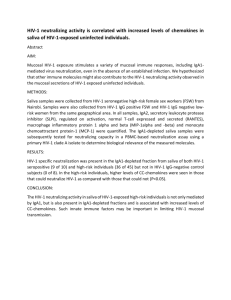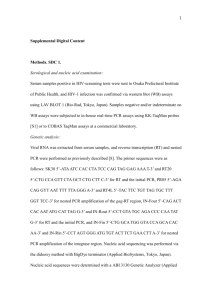Expression of complement inhibitor protein CD59 in human
advertisement
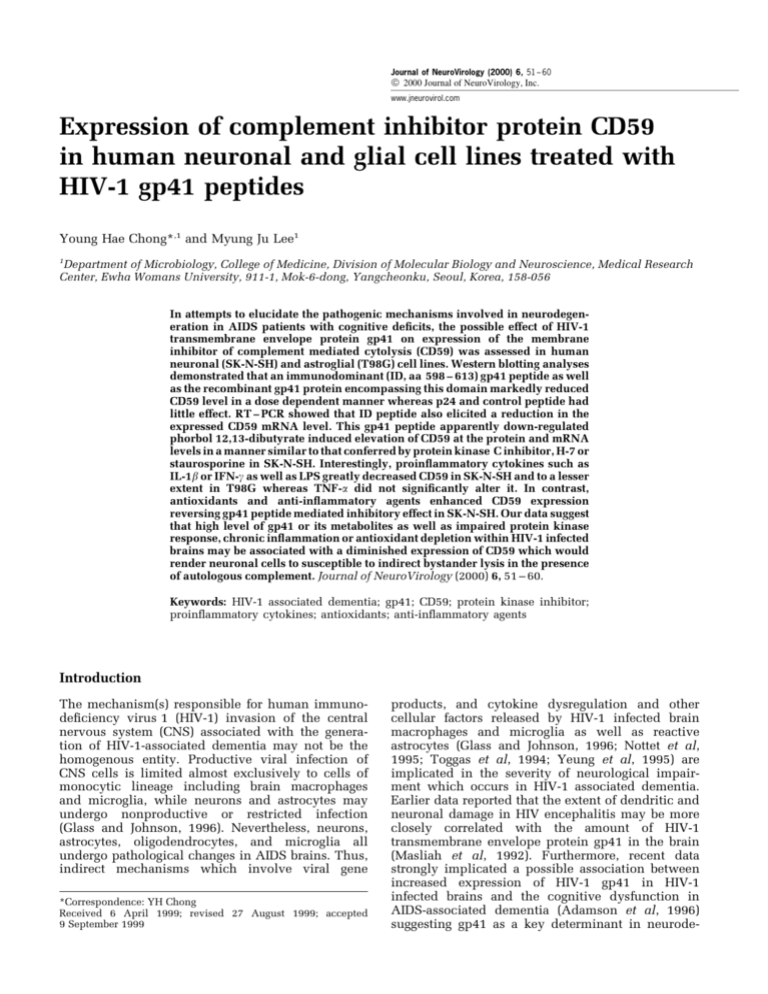
Journal of NeuroVirology (2000) 6, 51 ± 60 ã 2000 Journal of NeuroVirology, Inc. www.jneurovirol.com Expression of complement inhibitor protein CD59 in human neuronal and glial cell lines treated with HIV-1 gp41 peptides Young Hae Chong*,1 and Myung Ju Lee1 1 Department of Microbiology, College of Medicine, Division of Molecular Biology and Neuroscience, Medical Research Center, Ewha Womans University, 911-1, Mok-6-dong, Yangcheonku, Seoul, Korea, 158-056 In attempts to elucidate the pathogenic mechanisms involved in neurodegeneration in AIDS patients with cognitive de®cits, the possible effect of HIV-1 transmembrane envelope protein gp41 on expression of the membrane inhibitor of complement mediated cytolysis (CD59) was assessed in human neuronal (SK-N-SH) and astroglial (T98G) cell lines. Western blotting analyses demonstrated that an immunodominant (ID, aa 598 ± 613) gp41 peptide as well as the recombinant gp41 protein encompassing this domain markedly reduced CD59 level in a dose dependent manner whereas p24 and control peptide had little effect. RT ± PCR showed that ID peptide also elicited a reduction in the expressed CD59 mRNA level. This gp41 peptide apparently down-regulated phorbol 12,13-dibutyrate induced elevation of CD59 at the protein and mRNA levels in a manner similar to that conferred by protein kinase C inhibitor, H-7 or staurosporine in SK-N-SH. Interestingly, proin¯ammatory cytokines such as IL-1b or IFN-g as well as LPS greatly decreased CD59 in SK-N-SH and to a lesser extent in T98G whereas TNF-a did not signi®cantly alter it. In contrast, antioxidants and anti-in¯ammatory agents enhanced CD59 expression reversing gp41 peptide mediated inhibitory effect in SK-N-SH. Our data suggest that high level of gp41 or its metabolites as well as impaired protein kinase response, chronic in¯ammation or antioxidant depletion within HIV-1 infected brains may be associated with a diminished expression of CD59 which would render neuronal cells to susceptible to indirect bystander lysis in the presence of autologous complement. Journal of NeuroVirology (2000) 6, 51 ± 60. Keywords: HIV-1 associated dementia; gp41; CD59; protein kinase inhibitor; proin¯ammatory cytokines; antioxidants; anti-in¯ammatory agents Introduction The mechanism(s) responsible for human immunode®ciency virus 1 (HIV-1) invasion of the central nervous system (CNS) associated with the generation of HIV-1-associated dementia may not be the homogenous entity. Productive viral infection of CNS cells is limited almost exclusively to cells of monocytic lineage including brain macrophages and microglia, while neurons and astrocytes may undergo nonproductive or restricted infection (Glass and Johnson, 1996). Nevertheless, neurons, astrocytes, oligodendrocytes, and microglia all undergo pathological changes in AIDS brains. Thus, indirect mechanisms which involve viral gene *Correspondence: YH Chong Received 6 April 1999; revised 27 August 1999; accepted 9 September 1999 products, and cytokine dysregulation and other cellular factors released by HIV-1 infected brain macrophages and microglia as well as reactive astrocytes (Glass and Johnson, 1996; Nottet et al, 1995; Toggas et al, 1994; Yeung et al, 1995) are implicated in the severity of neurological impairment which occurs in HIV-1 associated dementia. Earlier data reported that the extent of dendritic and neuronal damage in HIV encephalitis may be more closely correlated with the amount of HIV-1 transmembrane envelope protein gp41 in the brain (Masliah et al, 1992). Furthermore, recent data strongly implicated a possible association between increased expression of HIV-1 gp41 in HIV-1 infected brains and the cognitive dysfunction in AIDS-associated dementia (Adamson et al, 1996) suggesting gp41 as a key determinant in neurode- Decreased CD59 expression by HIV-1 gp41 peptides YH Chong and MJ Lee 52 generative cascade ultimately leading to neuronal damage and dementia. Several lines of evidence suggest a dysregulation of the complement system in HIV-1 infected patients. The up-regulation of complement inhibitors such as the membrane inhibitor of reactive lysis (MIRL, CD59), decay activating factor (DAF, CD55) or membrane cofactor protein (MCP, CD46) and incorporation of these inhibitors in HIV-1 virions could lead to complement lysis resistance implicating complementary vaccine strategies including antiCD59, antiCD55, antiCFH to control HIV infection (Monte®ori et al, 1994; Saifuddin et al, 1997; Stoiber et al, 1997). In contrast, the expression of CD59 was decreased during HIV-1 infection and down-regulation of complement inhibitors may be associated with a signi®cant induction of cytolysis of T-cells in the presence of autologous complement leading to immunode®ciency due to T cell depletion (Weiss et al, 1992; Schmitz et al, 1995; Aries et al, 1997). In fact, HIV-1 gp41 in addition to its many cytopathic immune modifying properties has been shown to activate complement in an antibodyindependent manner leading to complement mediated enhancement of HIV-1 infection and disease progression (Ruegg and Strand, 1991; Denner et al, 1994; Haraguchi et al, 1995; Marschang et al, 1997). Thus, HIV-1 gp41 might affect neurons indirectly by acting in concert with complement mediators released by neighboring CNS cells or entering the brain during infection and in¯ammation. Considerable evidence implicates that complement activation occurs within CNS in in¯ammatory and degenerative diseases. A role of complement in tissue destruction has been suggested in pathological conditions as diverse as multiple sclerosis (MS), stroke, cerebral trauma and as Alzheimer disease (AD) (Morgan et al, 1997). CD59, a glycoprotein with a 18 ± 25 kDa anchored by glycosyl phophatidylinositol (GPI), is the membrane inhibitor of the assembly of membrane attack complex (MAC, C5b9) primarily by restricting C9 multiplicity thus protecting homologous cells from complement mediated damage. This major complement inhibitor CD59 is predominantly expressed in brain cells such as astrocytes/microglia as well as neurons and its de®ciency or neutralization may result in high susceptibility to damage by complement (Meri, 1990; Gasque and Morgan, 1996a; Gasque et al, 1996b; Akatsu et al, 1997). In fact, recent studies demonstrated that b-amyloid (Ab) of AD triggered local complement activation causing damage to adjacent neurons (Rogers et al, 1992) and neuronal cells are more vulnerable to Ab-induced complement mediated toxicity when CD59 is dysfunctional through phosphoinositide speci®c phospholipase C (PIPLC) treatment or neutralization by anti-CD59 antibody in vitro (Cadman and Puttfarcken, 1997; Shen et al, 1998). Despite such an important role of Journal of NeuroVirology CD59 in homologous restriction for preventing complement in tissue destruction in CNS disorders, complement activation leading to neuronal damage or downregulation of the major complement inhibitor CD59 in HIV-1 associated neurological disease have not been published. Since nerve cells are postmitotic, MAC formation on nervous tissues adjacent to local in¯ammatory milieu with HIV-1 infected macrophages/microglia would almost certainly have deleterious consequences, even as a purely undirected bystander lysis phenomenon (Morgan, 1994). In this regard, it will be of interest to examine the viral or cellular factors that could modulate CD59 expression in human brain cells. In the present study using RT ± PCR and Western blotting analyses, the effect of gp41 derived peptides on expression of CD59 was investigated in well-characterized neuroblastoma (SK-N-SH) and astroglioma (T98G) cell lines as models of human neuron and astrocytes (Ogino and Costa, 1992; Fontana et al, 1984). Effects of phobol ester and PKC inhibitor H7 or nonspeci®c protein kinase inhibitor staurosporine were also analyzed in order to further characterize the molecular mechanism involved in gp41 peptide mediated modulation of CD59 expression. In addition, proin¯ammatory cytokines, antioxidants or anti-in¯ammatory agents were employed to study the complex modulation of CD59 expression for possible therapeutic strategies of complement host defense functions in the control of HIV-1 associated neurological disease. Results In a view of potentially critical role of CD59 in the protection of neurons from complement damage, we employed Western blotting using speci®c antibody to assess the expression of CD59 in human brain cells. Speci®c immunoreactivities clearly demonstrated that both human neuronal (SK-N-SH) and astroglial (T98G) cell lines produced the MAC inhibiting CD59 protein with an apparent molecular weight of 20 kDa on electrophoresis under nonreducing condition (Figure 1). Both T98G and SK-N-SH to a lesser extent constitutively expressed CD59 protein which is mainly associated with membrane whereas undifferentiated THP1 expressed very low CD59 partially con®rming the previous report (Gasque and Morgan, 1996a). Concentrated supernatants from the same cultures were similarly subjected to SDS ± PAGE and Western blotting but failed to reveal the presence of soluble forms of CD59 (data not shown). Interestingly, Western blot analyses revealed that the treatment with a recombinant gp41 protein encoding an extracellular domain caused a signi®cant reduction of CD59 protein in both neuronal and astroglial cells (Figure 2, lane 5). This inhibitory effect of gp41 peptide was seen with a Decreased CD59 expression by HIV-1 gp41 peptides YH Chong and MJ Lee 53 Figure 1 Membrane localization of CD59 protein in human brain cell lines. Cell lysates were prepared and further fractionated into cytosol and membrane fractions and equal amount of protein (40 mg) in each sample was subjected to Western blot analysis using CD59 speci®c monoclonal antibody (MEM43) under nonreducing condition. Immunoblot analyses demonstrated the expressed CD59 in membrane fractions of human neuronal SK-N-SH and astrogial T98G cells. 4 h treatment in T98G, while CD59 protein level was too low to be detected in SK-N-SH under the same condition (data not shown). Thus, we performed our experiments with an 18 h treatment for the comparison of the effects between two different cells. Both the conserved immunodominant peptide (ID, aa 598 ± 613) and the adjacent immunosuppressive peptide (ISP, aa 583 ± 599) albeit a lesser extent were effective in decreasing production of CD59 protein (approximately 30 versus 65% of the control level, Figure 2, lanes 4 and 3). However, the recombinant capsid protein p24 or the control reverse peptide (PSI, aa 599 ± 583) had no such inhibitory effect under the same experimental condition. Furthermore, increasing concentrations of this ID peptide resulted in progressive inhibition with the maximal dose of 25 mM gp41 peptide at which CD59 was reduced to approximately 25% of the control level in SK-N-SH (Figure 3A). Similar dose dependent inhibitory effect was elicited by the recombinant gp41 protein and the reduction observed was about 55% of the control level at 1 mM concentration (Figure 3B). Chemical compounds and agonists targeting PKC were reported to increase CD59 production (Gasque et al, 1996b; Holguin et al, 1996). In order to further characterize underlying mechanism of this gp41 peptide mediated reduction of CD59, the effect of PKC agonist and inhibitor were analyzed and Figure 2 Effects of gp41 peptides, rGP41 and rP24 proteins on expression of CD59 protein in human brain cell lines. SK-N-H (A) and T98G (B) cells were incubated for 18 h in medium only (control), in presence of the reverse gp41 peptide (PSI, 25 mM of aa 598 ± 583) an immunosuppressive peptide (ISP, 25 mM of aa 583 ± 598), an immunodominant peptide (ID, 25 mM of aa 598 ± 613), the recombinant gp41 (rGP41, 1 mM), or the recombinant p24 (rP24, 1 mM). Total cell lysates were analyzed by 12.5% SDS ± PAGE followed by Western blotting as described in Figure 1. (C and D) Representation of the densitometric analysis of the immunoblots (A) and (B); numbers 1 ± 6 correspond to the different samples indicated in (A) and (B), respectively. Results are means of triplicates+s.e.m. (bars) values. Journal of NeuroVirology Decreased CD59 expression by HIV-1 gp41 peptides YH Chong and MJ Lee 54 compared to gp41 mediated response. As demonstrated in Figure 4A, the treatment with the phorbol ester PdBu (100 nM) for 18 h up-regulated CD59 protein level up to about 230% of the control level in SK-N-SH neuronal cells. Interestingly, this stimulatory effect of PdBu was completely abolished by a simultaneous treatment with ID peptide and even decreased lower than the control level (65% of the control level, Figure 4A, lane 4) but partially suppressed by ISP peptide (165% of the control level, Figure 4A, lane 3). Furthermore, the known PKC inhibitor, H-7 (10 mM) and nonspeci®c protein kinase inhibitor, staurosporine (10 nM) with a higher extent clearly elicited a downregulation of CD59, mimicking ID peptide in response to PdBu. In addition, RT ± PCR analysis demonstrated that SK-N-SH (Figure 4B) and T98G (data not shown) cell lines expressed CD59 mRNAs and this expression pattern of CD59 mRNA coincided well with CD59 expression at the protein level. Treatment with PdBu signi®cantly induced expression of CD59 mRNAs (160%). Despite the lower magnitude, addition of the gp41 peptides to culture media suppressed the expression pattern of CD59 mRNA. Furthermore, H7 or staurosporine induced down-regulation was mimicked to this inhibitory effect of gp41 peptides on expression of CD59 mRNA as observed in expression of CD59 protein level. In¯ammatory cytokines appear in association with HIV-1 associated neurological disease lesions and a strong in¯ammatory response may be neurotoxic, exacerbating the chronic in¯ammation in AIDS demented brains and perhaps in other neurological disorders including AD. In order to determine the possible modulation of the membrane complement inhibitor by various proin¯ammatory cytokines, we investigated their effects on expression of CD59 at the protein level. We performed dose response curves of each cytokine and found dose dependent inhibitory responses (data not shown). Signi®cant repressive effects were observed at the concentrations used in Figure 5. Unexpectedly, stimulation of cell cultures with proin¯ammatory cytokines such as IL-1b (10 ng/ ml), LPS (10 mg/ml), IFN-g (10 ng/ml) or IL-1b (10 ng/ml) for 18 h failed to up-regulate CD59 but greatly decreased it whereas TNF-a (10 ng/ml) had no discernible effects in SK-N-SH cells (Figure 5A). In contrast, treatment with these cytokines resulted in slightly decreased expression of CD59 with the maximal effect by LPS in T98G cells (Figure 5B). To further determine possible therapeutic strategies of complement host defense functions in the control of HIV-1 associated neurological disease, we also examined whether antioxidants or anti-in¯ammatory agents affect gp41 mediated reduction of CD59 protein in human brain cells. We performed our experiments with the speci®c doses of antioxidants or anti-in¯ammatory agents which were frequently used in vitro experiments by other investigators for their biological activities (Kalebic et al, 1994; Corasaniti et al, 1995). Treatment with antioxidants such as GSH (15 mM) or NAC (20 mM) and anti- Figure 3 Expression of CD59 protein in human neuronal cell line treated with different concentrations of gp41 peptides. Equal amounts of protein (40 mg) in each cell lysate was subjected to Western blot analysis which showed CD59 protein from SK-N-SH treated with increasing gp41 peptide (ID, aa 598 ± 613) (A) and the recombinant gp41 (rGP41) protein (B). The presented data are representatives that were obtained from three experiments. (C and D) Representation of the densitometric analysis of the immunoblots (A) and (B); numbers 1 ± 6 correspond to the different samples indicated in (A) and (B), respectively. Results are means of triplicates+s.e.m. (bars) values. Journal of NeuroVirology Decreased CD59 expression by HIV-1 gp41 peptides YH Chong and MJ Lee 55 Figure 4 Effects of phorbol ester and PK inhibitors on CD59 expression in human neuronal cell line. Immunoblot analyses (A) and RT ± PCR (B) showed a phobol ester (PdBu, 100 nM) induced CD59 production and its down-regulation by the cotreatment with gp41 peptides (ID & ISP, 25 mM), H7 (10 mM), or staurosporine (SSP, 10 nM) but not by reverse gp41 peptide (PSI, 25 mM) in SK-N-SH. In A, equal amounts of each cell lysate was analyzed by 12.5% SDS ± PAGE followed by Western blotting as described in Figure 2. In B, speci®c fragments of CD59 and b-actin mRNAs were analyzed by electrophoresis on agarose gel and visualized by ethidium bromide staining and speci®city of each ampli®cation product was demonstrated by Southern blot hybridization on right side. (C and D) Representation of the densitometric analysis of the immunoblots (A) and (B); numbers 1 ± 6 correspond to the different samples indicated in (A) and (B), respectively. Results are means of triplicates+s.e.m. (bars) values. Figure 5 Modulation of CD59 expression by of proin¯ammatory cytokines in SK-N-SH and T98G cells. Effects of proin¯ammatory cytokines on CD59 expression in SK-N-SH (A) and T98G (B) cells which were stimulated with TNF-a (10 ng/ml), IL-1b (10 ng/ml), LPS (10 mg/ml), or IFN-g (10 ng/ml) for 18 h and each clear lysate was analyzed on the immunoblots. Shown is a representative one of triplicate experiments. (C and D) Representation of the densitometric analysis of the immunoblots (A) and (B); numbers 1 ± 5 correspond to the different samples indicated in (A) and (B), respectively. Results are means of triplicates+s.e.m. (bars) values. Journal of NeuroVirology Decreased CD59 expression by HIV-1 gp41 peptides YH Chong and MJ Lee 56 Figure 6 Effects of antioxidants and anti-in¯ammatory agents on a ID peptide mediated decrease of CD59 protein level in SK-N-SH and T98G cells. Immunoblots showed CD59 in cell lysates of SK-N-SH (A) and T98G (B) cells which were pretreated with antioxidants such as glutathione (GSH, 15 mM) or N-acetylcysteine (NAC, 20 mM) and anti-in¯ammatory agents such as dexamethasone (DEX, 1 mM) or indomethacin (INDO, 10 mM) for 2 h and further incubated for 18 h without or with addition of ID (25 mM) peptide. Shown is a representative one of triplicate experiments. (C and D) Representation of the densitometric analysis of the immunoblots (A) and (B); numbers 1 ± 10 correspond to the different samples indicated in (A) and (B), respectively. Results are means of triplicates+s.e.m. (bars) values. in¯ammatory agents DEX (1 mM) or INDO (10 mM) for 18 h greatly augmented CD59 expression in SKN-SH neuronal cells (Figure 6A, lanes 7 ± 10). Furthermore, anti-in¯ammatory agents or antioxidants albeit a lesser extent substantially reversed the inhibitory effect conferred by ID peptide even enhancing CD59 expression as compared to the control (Figure 6A, lanes 1 ± 6). In contrast, these agents were less effective in inducing CD59 in T98G astroglial cells and thus failed to reverse the gp41mediated suppression of CD59 expression (Figure 6B, lanes 7 ± 10). Rather, antioxidant, NAC signi®cantly downregulated CD59 at the protein level and this effect appeared to be addictive to inhibitory effect of ID peptide in T98G (Figure 6B, lanes 1 ± 6). Discussion A recent report implicates the possible link between HIV-1 transmembrane envelope protein gp41 and the severity of neurological symptoms associated with HIV-1-associated dementia (Masliah et al, 1992; Adamson et al, 1996). Thus, the biological functions of HIV-1 TM protein gp41 remains critical to unraveling the mechanism underlying cognitive de®cits in AIDS patients. We are here reporting that HIV-1 gp41 has a potential role for a downregulation of complement regulatory protein CD59, which is predominantly expressed in the CNS Journal of NeuroVirology (Akatsu et al, 1997) in well characterized human neuronal and astroglial cell lines. Treatments with increasing concentrations of an immunodominant (ID) peptide as well as the recombinant gp41 protein encompassing this domain were correlated with a decreased production of CD59. The higher amount of peptide required to down-regulate CD59 expression in vitro than the concentration of gp41 expected in vivo is possibly because most synthetic peptides may have failed to adopt the biologically active conformation as previously suggested (Ruegg and Strand, 1991; Denner et al, 1994). Recent study demonstrated that neuroblastoma expressed CD59 and neutralization of CD59 rendered the cells susceptible to complement killing implicating that complement might play a role in neuronal loss and that treatment with complement inhibitors might be of therapeutic value (Gasque and Morgan, 1996a). It is also interesting to note that decreased CD59 level was closely correlated with the appearance of apoptotic cells which could in turn activate alternative pathway of the homologous complement and be cleared by phagocytosis (Jones and Morgan, 1995; Tsuji et al, 1994). Furthermore, ID peptide of gp41 which has been shown to act as the primary complement-activation and ®xation of C1q (Marschang et al, 1997) may cause perpetuation of in¯ammation and susceptibility to opportunistic infection due to complement component consumption leading to an enhanced productive HIV-1 Decreased CD59 expression by HIV-1 gp41 peptides YH Chong and MJ Lee 57 infection and transmission. In this regard, our data could strongly suggest that HIV-1 gp41 mediated reduction of CD59 may cause uninfected neurons or astroglial cells more susceptible to bystander complement damage and lysis in the complement activating environment of an in¯ammatory site. Earlier study demonstrated that CD59 gene contains the promoter regions for constitutive and phorbol myritstoyl acetate (PMA) inducible transcription although responsiveness to PMA is cell line speci®c (Holguin et al, 1996). Our present study demonstrated that the treatment with PKC agonist signi®cantly caused up-regulation of CD59 in human neuronal cell line as assessed at protein and mRNA levels. This ®nding is in good agreement with previous reports demonstrating phorbol esterinduced increase of CD59 in other human cell lines such as erythroid/myeloid leukemia cell line K-562 and oligodendrocyte cell line HOG (Gasque et al, 1996b; Marchbank et al, 1995). In our study, the gp41 peptide mediated down-regulation of CD59 elevation in response to PdBu both in neuronal and glial cell lines and this inhibitory effect similar to that conferred by PKC inhibitor, H-7 or staurosporine, an inhibitor with broad, non-selective protein kinase inhibitory pro®le. These ®ndings strongly implicate that HIV-1 gp41 could be one of the viral modulators leading to a decline of CD59 expression at the transcriptional and translational levels through an inhibition of PKC dependent and independent signal pathways within CNS. This study is further supported by recent studies for physiological roles of gp41 peptide in the disturbance of PKC signal pathway leading to the inhibition of T lymphocyte activation and a suppression of cellular immunity (Ruegg and Strand, 1992; Koka et al, 1995; Nokta et al, 1994). Further study will elucidate other intracellular signaling pathway involved in the expression of CD59 in human brain cells and other possible sites of regulation including inhibition of the recycling of membrane bound CD59 or mobilization of CD59 from the intracellular storage pool. Cytokine dysregulation and a strong in¯ammatory response may be neurotoxic, exacerbating the chronic in¯ammation in association with HIV-1 associated neurological disease lesions and perhaps in other neurological disorders including AD. The HIV-1 envelope epitopes in the extracellular domain of gp41 appear to be a potent modulator of cytokine production inducing proin¯ammatory cytokines involving IL-1b, and TNF-a in human glial (Koka et al, 1995). Interestingly, our present study here clearly demonstrated that proin¯ammatory cytokines IL-1b or IFN-g as well as LPS remarkably decreased CD59 level in human neuronal cell line SK-N-SH. Furthermore, stimulation with these proin¯ammatory cytokines did not greatly in¯uence the expression of CD59 in human astroglial cell line T98G as previously observed in rat astrocytes (Rogers et al, 1996). These observations implicate that neuronal cells are more sensitive to proin¯ammatory cytokines in downregulating CD59 than astroglial cells and that different cell populations may show differences in regulatory pattern for the CD59 expression. HIV-1 associated dementia is a critical disorder characterized by cognitive, motor, and behavioral changes similar to AD. Speci®c in¯ammatory mechanisms, including the complement activation, cytokine-driven acute phase response, and microglial activation may contribute to neurodegeneration associated with AD. This in¯ammatory hypothesis of AD is strongly supported by epidemiological evidence and results of a pilot clinical trial studies with the anti-in¯ammatory drugs indomethacin or prednisone which suppressed progress of the disease (McGeer and McGeer, 1995; Aisen, 1997). Similarly, the clinical management of HIV-1 associated arthritis with anti-in¯ammatory drug indomethacin directly inhibited HIV-1 replication (Itescu, 1996). Furthermore, up-regulation of CD59 by anti-in¯ammatory agents such as indomethacin and dexamethasone or anti-oxidants GSH and NAC albeit a lesser extent as demonstrated here strongly implicates their possible role in reversing the HIV-1 gp41 mediated decrease of CD59 at the protein level. This up-regulation of CD59 may confer increased protection of neuronal cells against complement mediated lysis in the in¯ammatory milieu. Further study will clarify the possibility that anti-in¯ammatory agents could effectively enhance CD59 expression by interfering with production of proin¯ammatory cytokines which clearly decreased CD59 expression as observed in this study. Taken all together, HIV-1 gp41 which has been shown as a key determinant associated with pathogenesis of AIDS dementia could be a viral modulator leading to a down-regulation of CD59, the dominant CNS membrane inhibitor of complement mediated cell lysis, at both protein and mRNA levels during chronic in¯ammation in HIV-1 infected brains. In addition, impaired PKC or other protein kinase responses, dysregulation of proin¯ammatory cytokines and antioxidant depletion as recently shown in HIV-1 infection (Herzenberg et al, 1997) may cause the decline of CD59 which would render neuronal cells to be susceptible to indirect bystander lysis in the presence of autologous complement. This process could be relevant to part of the molecular mechanisms underlying neurodegenerative cascade in AIDS associated dementia. Materials and methods Materials Synthetic peptides corresponding to the putative immunodominant peptide (ID) encoding aa sequences 598 ± 613 (QLLGIWGCSGKLICTT) or the Journal of NeuroVirology Decreased CD59 expression by HIV-1 gp41 peptides YH Chong and MJ Lee 58 adjacent immunosuppressive peptide (ISP) encoding aa sequences 583 ± 599 (LQARILAVERYLKDQQL) and its reverse peptide (PSI, aa sequences 599 ± 583) of HIV-1 transmembrane envelope protein gp41 (Ratner et al, 1985) were purchased from QCB (Hopkinton, MA, USA) and prepared as previously described (Thielens et al, 1993). Recombinant HIV-1 gp41 protein encompassing an ectodomain and capsid protein p24 were generous gifts from Green Cross Company (Seoul, Korea). The peptides and proteins used in this study were analyzed for endotoxin contamination by Limulus amebocyte lysate test (COATEST, Chromogenix, Charleston, SC, USA), and all were found to be free of endotoxin contamination (50.1 EU/ mL). Various cytokines and other chemicals used in this study were purchased from Sigma Chemical Co. (St. Louis, MO, USA). Cell cultures The human neuroblastoma and astroglioma cell lines, SK-N-SH and T98G, were obtained from Dr Y.H. Suh (Seoul National University) and American Type Culture Collection (ATCC) (Rockille, MD, USA) respectively and seeded at 26105/60 cm2 tissue culture dishes and grown for 2 days in DMEM supplemented with 10% fetal bovine serum (FBS). The human monocytic cell line THP1 used as a model for microglia was also obtained from ATCC and maintained as described above. Before adding the gp41 peptides cell cultures were incubated for 2 h in serum free medium supplemented with 0.5% glucose in order to eliminate the effects of other proteins present in serum, the stimulants such as phorbol 12,13-dibutyrate (PdBu) or proin¯ammatory cytokines into the culture media and further incubated for 18 h. Cultures were cotreated with PKC inhibitor H-7 or nonspeci®c protein kinase inhibitor staurosporine for the same period of time or pretreated with reducing agents, glutathione (GSH) or N-acetyl cysteine (NAC) and anti-in¯ammatory agents, dexamethasone (DEX) or indomethacin (INDO) for 2 h before exposure to gp41 peptides and further incubated for 18 h to examine their effects on CD59 expression. The cleared lysates and membrane fraction were prepared to analyze expression of CD59 protein or mRNA levels as previously described (Chomaczisky and Sacchi, 1987; Mizuguchi et al, 1992). Western blot analysis The clear lysates were normalized for the equal amount of proteins by BCA method (Sigma, MO, USA) and further assayed for immunoreactivity according to the protocol by manufacturer (ECL kit, Journal of NeuroVirology Amersham) as previously described (Chong, 1997). Human erythrocyte obtained from a healthy volunteer was prepared as detailed previously (Spiller et al, 1996) and used as a control to ascertain speci®city for CD59 protein. Under nonreducing condition, monoclonal antibody MEM-43 (MCA1054, Serotec) used as a primary antibody recognized CD59 (20 kDa) of human erythrocytes. RNA extraction and ampli®cation using RT ± PCR Complementary DNA strand (cDNA) synthesis and RT ± PCR technique as previously described (Chong, 1997; Gasque and Morgan, 1996a) were used to detect expression of human CD59 and bactin mRNAs. The primers and probes purchased from Amitof (MA, USA) were as follows: (a) human CD59 (Sawada et al, 1992: sense, 5-ATGGGAATCCAAGGAGGGTCT-3, antisense, 5-TGCCAGAAATGGAGTCACCAG-3, probe, 5-CAGTGCTACAACTGTCCTAAC-3, (b) human b-actin (Ponte, 1984): sense, 5-ACGGGGTCACCCACACTGTGC-3, antisense, 5-CTAGAAGCATTTGCGGTGGAC-3, probe, 5-GACAGGATGCAGAAGGAGAT-3. PCR ampli®cation was carried out at 94, 60, 728C for 1, 1, and 2 min, respectively for 30 cycles for CD59 and 25 cycles for b-actin which there was a linearity in ampli®cation of each product using a Perkin-Elmer 9600 Thermal Cycler (Cetus). Nonradioactive Southern blot hybridization with internal ¯uorescein-labeled primer was performed as a speci®city control according to the instruction of the manufacturer (ECL kit, Amersham). To normalize the values of CD59 mRNA levels, human b-actin was ampli®ed in parallel tube to determine the ratio of intensity of CD59 versus b-actin ampli®cation products. Data analysis Figures are the representatives from three independent experiments. The signals were quanti®ed by densitometric scanning using UltroScan XL laser densitometer (LKB, Model 2222-020) to determine the intensity of each band. The arbitrary densitometric units were converted to a percentage of the control response for each individual experiment. Acknowledgements We thank Green Cross Company for the recombinant gp41 and p24 proteins. This work was supported by a full grant of basic medical science research fund from Ministry of Education (1997), Republic of Korea for Young Hae Chong. Decreased CD59 expression by HIV-1 gp41 peptides YH Chong and MJ Lee 59 References Adamson DC, Wildemann B, Sasak MI, Glass JD, Mcarthur JC, Christov VI, Dawson TM, Dawson VL (1996). Immunologic NO synthase: elevation in severe AIDS dementia and induction by HIV-1 gp41. Science 274: 1917 ± 1921. Aisen PS (1997). In¯ammation and Alzheimer's disease: mechanisms and therapeutic strategies. Gerontol 43: 143 ± 149. Akatsu H, Yamada T, Okada N, Yamamoto T, Yamashina M, Okad HA (1997). Unique expression of HRF (CD59) in human nervous tissue. Microbiol Immunol 41: 321 ± 329. Aries SP, Schaaf B, Hansen F, Weyrich K, Kurowski V, Dennin R, Dalhoff K (1997). Expression of complement receptors and regulatory proteins on alveolar CD4+ lymphocytes from human immunode®ciency virus-1 infected individuals. Eur Resp J 10: 1736 ± 1741. Cadman ED, Puttfarcken PS (1997). b-amyloid peptides initiate the complement cascade without producing a comparable effect on the terminal pathway in vitro. Expt Neuronal 146: 388 ± 394. Chong YH (1997). Effect of a carboxy-terminal fragment of the Alzheimer amyloid precursor protein on expression of proin¯ammatory cytokines in rat glial cells. Life Sci 23: 2323 ± 2333. Chomczinsky P, Sacchi N (1987). Single step method of RNA isolation by acid guanidium thiocyanate-phenolchloroform extraction. Anal Biochem 162: 156 ± 159. Corasaniti MT, Melino G, Navarra M, Garaci E, FinazziAgro A, Nistico G (1995). Death of cultured neuroblastoma cells induced by HIV-1 gp120 is prevented by NMDA receptor antagonists and inhibitors of nitric oxide and cycloxygenase. Neurodegen 4: 315 ± 321. Denner J, Norley S, Kurth R (1994). The immunosuppressive peptide of HIV-1: functional domains and immune response in AIDS patients. AIDS 8: 1063 ± 1072. Fontana A, Fierz W, Wekerle H (1984). Astrocytes present myelin basic protein to encephalitogenic cell lines. Nature 307: 273 ± 276. Gasque P, Morgan BP (1996a). Complement regulatory protein expression by a human oligodendrocyte cell line: cytokine regulation and comparison with astrocytes. Immunol 89: 338 ± 347. Gasque P, Thomas A, Fontaine M, Morgan BP (1996b). Complement activation on human neuroblastoma cell lines in vitro: route of activation and expression of functional complement regulatory proteins. J Neuroimmunol 66: 29 ± 40. Glass JD, Johnson RT (1996). Human immunode®ciency virus and the brain. Annu Rev Neurosci 19: 1 ± 26. Haraguchi S, Good RA, Day NK (1995). Immunosuppressive retroviral peptides: cAMP and cytokine patterns. Immunol Today 16: 595 ± 603. Herzenberg LA, De Rosa SC, Dubs JG, Roederer M, Anderson MT, Ela SW, Herzenberg LA (1997). Glutathione de®ciency is associated with impaired survival in HIV disease. Proc Natl Acad Sci USA 94: 1967 ± 1972. Holguin MH, Martin CB, Eggett T, Parker CJ (1996). Analysis of the gene that encodes the complement regulatory protein, membrane inhibitor of reactive lysis (CD59). Identi®cation of an alternatively spliced exon and characterization of the transcriptional regulatory regions of the promoter. J Immunol 157: 1659 ± 1668. Itescu S (1996). Rheumatic aspects of acquired immunode®ciency syndrome. Cur Opin Rheumatol 8: 346 ± 353. Jones J, Morgan BP (1995). Apoptosis is associated with reduced expression of complement regulatory molecules, adhesion molecules and other receptors on polymorphonuclear leucocytes: functional relevance and role in in¯ammation. Immunol 86: 651 ± 660. Kalebic T, Masiero L, Onisto M, Garbisa S (1994). HIV-1 modulates the expression of gelatinase A and B in monocyic cells. Biochem Biophy Res Comm 205: 1243 ± 1249. Koka P, He K, Zack JA, Kitchen S, Peacock W, Fried I, Tran T, Yashar SS, Merrill JE (1995). Human immunode®ciency virus 1 envelope proteins induce interleukin 1, tumor necrosis factor alpha, and nitric oxide in glial cultures derived from fetal, neonatal, and adult human brain. J Exp Med 182: 941 ± 951. Marchbank KJ, Morgan BP, Van Den Berg CW (1995). Regulation of CD59 expression on K562 cells: effects of phorbol myristate acetate, cross-linking antibody and non-lethal complement attack. Immunol 85: 146 ± 152. Marschang P, Kruger U, Ochsenbauer C, Gurtler L, Hittmair A, Bosch V, Patsch JR, Dierich MP (1997). Complement activation by HIV-1 infected cells: the role of transmembrane glycoprotein gp41. J. Acq. Immun. De®ciency Syndrome. J Acquired Immune De®c Syndr Hum Retrovirol 14: 102 ± 109. Masliah E, Achim CL, Ge N, Eeteresa RD, Terry RD, Wiley CA (1992). Spectrum of human immunode®ciency virus-associated neocortical damage. Ann Neurol 32: 321 ± 329. McGeer Pl, McGeer EG (1995). The in¯ammatory response system of brain: implications for therapy of Alzheimer and other neurodegenerative diseases. Brain Res Rev 21: 195 ± 218. Meri S, Morgan BP, Davies A, Danials RH, Olavesen MG, Waldmaann H, Lachmaann PJ (1990). Human protein (CD59), an 18,000 ± 20,000 MW complement lysis restriction factor, inhibits C5b-8 catalysed insertion of C9 into lipid bilayers. Immunol 71: 1 ± 9. Mizuguchi M, Ikeda K, Namba Y, Kim SU (1992). Alzheimer's disease b-amyloid precursor protein in rat neural cells in culture. Gerontol 38: 15 ± 23. Monte®ori DC, Cornell RJ, Zhou ZY, Zhou ZT, Hirsch VM, Johnson PR (1994). Complement control proteins, CD46, CD55, and CD59, as common surface constituents of human and siminan viruses and possible targets for vaccine protection. Virol 205: 82 ± 92. Morgan BP (1994). Clinical complementology: Recent progress and future trends. Eur J Clinic Invest 24: 219 ± 228. Journal of NeuroVirology Decreased CD59 expression by HIV-1 gp41 peptides YH Chong and MJ Lee 60 Morgan BP, Gasque P, Singhrao S, Piddlesden SJ (1997). The role of complement in disorders of the nervous system. Immunopharmacol 38: 43 ± 50. Nokta MA, Hassan MI, Morgan JA, Loesch KA, Pollard RB (1994). Protein kinase C and intracellular free Ca++: relationship to human immunode®ciency virus (HIV)-induced cellularhyporesponsiveness. Proc Soc Exp Biol Med 207: 284 ± 291. Nottet HS, Jett M, Flanagan CR, Zhai QH, Persidky Y, Rizzimo A, Berton EW, Gents P, Baldwin T, Schwartz J, Labenz CJ, Gendelman HE (1995). A regulatory role for astrocytes in HIV-1 encephalitis: An overexpression of eicosanoids, platelet-activating factor, and tumor necrosis factor- by activated HIV-1-infected monocytes is attenuated by primary human astrocytes. J Immunol 154: 3567 ± 3581. Ogino Y, Costa T (1992). The epithelial phenotype of human neuroblastoma cells express bradykinin. J. Neurochem. J Neurochem 58: 46 ± 56. Ponte P, Ng S-Y, Gunning P, Kedes L (1984). Evolutionary conservation in the untranslated regions of actin mRNAs: DNA sequence of a human beta-actin cDNA. Nucleic Acids Res 12: 1687 ± 1696. Ratner L, Haseltine W, Partarca R, Livak KJ, Statcich B, Josephs SF, Doran ER, Rafaski JA, Whitehorn EA, Baumeister K, Ivanoff L, Peytteway SR JR, Pearson JA, Lautenberger ML, Papas TS, Ghrayeb J, Chang NT, Gallo R, Wong-Staal CF (1985). Complete nucleotide sequence of the AIDS virus, HTLV-III. Nature 313: 277 ± 284. Rogers CA, Gasque P, Piddlesden SJ, Okada N, Holers VM, Morgan BP (1996). Expression and function of membrane regulators of complement on rat astrocytes in culture. Immunol 88: 153 ± 161. Rogers J, Cooper N, Webster S, Schultz J, McGeer P, Styren SD, Civin WH, Brachova L, Bradt B, Ward P, Lieberburg I (1992). Complement activation by bamyloid in Alzheimer's disease. Proc Natl Acad Sci USA 89: 10016 ± 10020. Ruegg CL, Strand MA (1991). Synthetic peptide with sequence identity to the transmembrane protein Gp41 of HIV-1 inhibits distinct lymphocytes activation pathways dependent on protein kinase C and intracellular calcium in¯ux. Cell Immunol 137: 1 ± 13. Saifuddin M, Hedayati T, Atkinson JP, Holguin MH, Parker CJ, Spear GT (1997). Human immunode®ciency virus type 1 incorporates both glycosyl phosphatidylinositol-anchored CD55 and CD59 and integral membrane CD46 at levels that protect from complement-mediated destruction. J Gen Virol 78: 1907 ± 1911. Journal of NeuroVirology Sawada R, Ohashi K, Anaguchi H, Okazaki H, Hattori M, Minao N, Naruto M (1992). Isolation and expression of the full-length cDNA encoding CD59 antigen of human lymphocytes. DNA Cell Biol 9: 213 ± 220. Schmitz J, Zimmer JP, Kluxen B, Aries S, Bogel M, Gigli I, Schmitz H (1995). Antibody-dependent complement mediated cytotoxicity in sera from patients with HIV-1 infection is controlled by CD55 and CD59. J Clin Invest 96: 1520 ± 1526. Shen Y, Sullivan T, Lee C-M, Meri S, Shiosaki K, Lin CW (1998). Induced expression of neuronal membrane attack complex and cell death by Alzheimer's bamyloid peptide. Brain Res 796: 187 ± 197. Spiller OB, Moretto G, Ki SU, Morgan BP, Devine DV (1996). Complement expression on astrocytes and astrocytoma cell lines: failure of complement regulation at the C3 level correlates with very low CD55 expression. J Neuroimmunol 71: 97 ± 106. Stoiber H, Clivio A, Dierich MP (1997). Role of complement in HIV infection. Annu Rev Immunol 15: 649 ± 674. Thielens NM, Bally IM, Ebenbichler CF, Dierich MP (1993). Further characterization of the interaction between the C1q subcomponent of human C1 and the transmembrane envelope glycoprotein gp41 of HIV-1. J Immunol 151: 6583 ± 6592. Toggas SM, Masliah E, Rockenstein EM, Mucke L (1994). Central nervous system damage produced by expression of the HIV-1 coat protein gp120 in transgenic mice. Nature 367: 188 ± 193. Tsuji S, Kaji K, Nagasawa S (1994). Activation of the alternative pathway of human complement by apoptotic human umbilical vein endothelial cells. J Biochem 116: 794 ± 800. Weiss L, Okada N, Haeffner Cavaillon N, Hattori T, Faucher C, Kazatchkine MD, Okada H (1992). Decreased expression of the membrane inhibitor of complement-mediated cytolysis CD59 on T-lymphocytes of HIV-infected patients. AIDS 6: 379 ± 385. Yeung MC, Pulliam L, Lau AS (1995). The HIV envelope protein gp120 is toxic to human brain-cell cultures through the induction of interleukin-6 and tumor necrosis factor. AIDS 9: 137 ± 143.
